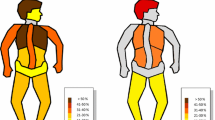Abstract
Purpose
Trauma mechanisms and patterns of severe injuries during the Estonian independence have not been evaluated. The aim of the study was to compare the incidence and outcomes of severe injuries between time periods of early independence from the Soviet Union and the present time.
Methods
After the ethics review board approval, all adult trauma admissions to major trauma facilities in 1993–1994 and 2013–2014 with Injury Severity Score >15 were identified. Data collection included demographics, injury severity variables, interventions, and in-hospital outcomes. Primary outcome was in-hospital mortality. Secondary outcomes included incidence of penetrating trauma, hospital length of stay (HLOS), and in-hospital complications. Primary outcome difference comparing the two time segments was determined using logistic regression analysis.
Results
A total of 1064 patients were included, 593 and 471 from 1993–1994 to 2013–2014, respectively. Incidence of penetrating trauma during 1993–1994 was 11.1 % and in 2013–2014 at 6.4 % (p = 0.007). Gunshot injuries constituted 62.1 and 23.3 % of all penetrating trauma in 1993–1994 and 2013–2014, respectively (p < 0.001). The overall mean HLOS was 15.5 ± 19.8 days and did not differ between the periods. The rate of adjusted complications showed a trend for a decreased incidence (adj. p = 0.064). Adjusted mortality rate was 50.3 and 16.4 % during 1993–1994 and 2013–2014, respectively (adj. OR 7.01; 95 % CI 4.69–10.47; p < 0.001).
Conclusions
Effective law enforcement, gun control, evolution of trauma system, and reduction of interpersonal violence have all contributed to a significant decrease in penetrating trauma incidence and all-cause adjusted mortality during the 20 years of Estonian independence.

Similar content being viewed by others
References
National Institute for Health Development. http://pxweb.tai.ee/esf/pxweb2008/Dialog/Saveshow.asp. Accessed 18 Aug 2015.
Gennarelli TA, Wodzin E, et al. The Abbreviated Injury Scale 2005. Update 2008. American Association for Automotive Medicine (AAAM), Des Plaines, IL. 2008.
TraumaRegister DGU(®). 20 years of trauma documentation in Germany—actual trends and developments. Injury. 2014;45(Suppl 3):S14–9.
Di Saverio S, Gambale G, Coccolini F, Catena F, Giorgini E, Ansaloni L, Amadori N, Coniglio C, Giugni A, Biscardi A, Magnone S, Filicori F, Cavallo P, Villani S, Cinquantini F, Annicchiarico M, Gordini G, Tugnoli G. Changes in the outcomes of severe trauma patients from 15-year experience in a Western European trauma ICU of Emilia Romagna region (1996–2010). A population cross-sectional survey study. Langenbecks Arch Surg. 2014;399(1):109–26.
Siman-Tov M, Radomislensky I, Peleg K. Reduction in trauma mortality in Israel during the last decade (2000–2010): the impact of changes in the trauma system. Injury. 2013;44(11):1448–52.
Estonian Emergency Medical Services Association. Estonian Emergency Medical Services Development Plan. 2006. https://www.sm.ee/sites/default/files/content-editors/eesmargid_ja_tegevused/Tervis/Tervishoiususteem/Arstide_erialade_arengukavad/kiirabi_arengukava_2007_-_2013.pdf. Accessed 4 Aug 2016.
Ambulance Care in Europe. 2010. http://www.eena.org/uploads/gallery/files/pdf/report-ambulancecare-in-europe-jan-2010%20(1).pdf. Accessed 5 Aug 2016.
Teataja R. Gun law. https://www.riigiteataja.ee/akt/RelvS. Accessed 21 May 2016.
Brinck T, Handolin L, Paffrath T, Lefering R. Trauma registry comparison: six-year results in trauma care in Southern Finland and Germany. Eur J Trauma Emerg Surg. 2015;41(5):509–16.
Demetriades D, Martin M, Salim A, Rhee P, Brown C, Doucet J, Chan L. Relationship between American College of Surgeons trauma center designation and mortality in patients with severe trauma (injury severity score >15). J Am Coll Surg. 2006;202(2):212–5.
Asensio JA, Berne J, Demetriades D, Murray J, Gomez H, Falabella A, Fox A, Velmahos G, Shoemaker W, Berne TV. Penetrating esophageal injuries: time interval of safety for preoperative evaluation–how long is safe? J Trauma. 1997;43(2):319–24.
Association for the Advancement of Automotive Medicine (AAAM). 2015. http://www.aaam.org. Accessed 27 Sept 2016.
Author information
Authors and Affiliations
Corresponding author
Ethics declarations
Conflict of interest
Sten Saar, Maksim Sokirjanski, Liina-Kadi Junkin, Juhan Laos, Anu-Liis Laar, Ingrid Merioja, Urmas Lepner, Leonhard Kukk, Andrus Remmelgas, Toomas Asser, Kaire Innos, Joel Starkopf, and Peep Talving declare that they have no conflict of interest.
Rights and permissions
About this article
Cite this article
Saar, S., Sokirjanski, M., Junkin, L.K. et al. Evolution of severe trauma in Estonia comparing early versus established independence of the state. Eur J Trauma Emerg Surg 43, 791–796 (2017). https://doi.org/10.1007/s00068-016-0731-0
Received:
Accepted:
Published:
Issue Date:
DOI: https://doi.org/10.1007/s00068-016-0731-0




